Get the weekly SPARTANAT newsletter.
Your bonus: the free E-Book from SPARTANAT.
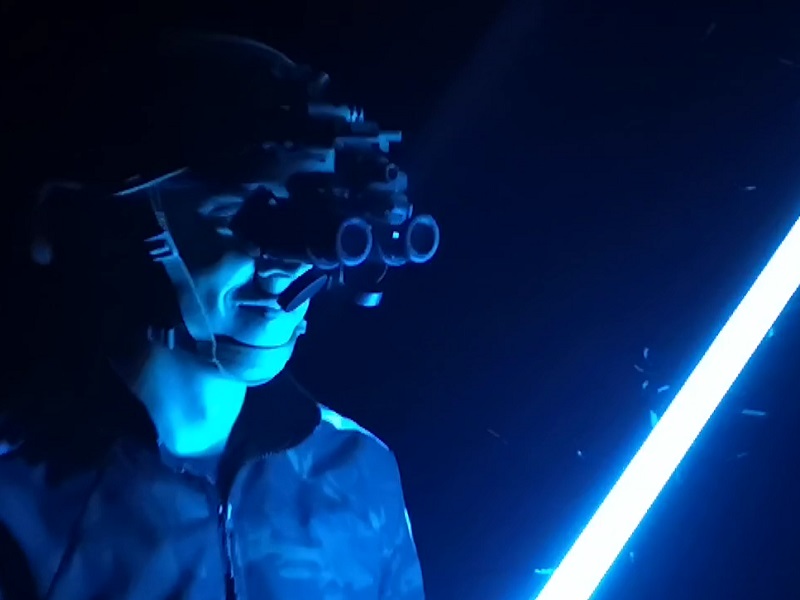
The standard night vision device used by many Special Forces is currently the AN/PVS-31 from L3 Harris in the USA. We had the opportunity to examine one in detail and of course want to share our experiences with you. You can watch the video above in the header.
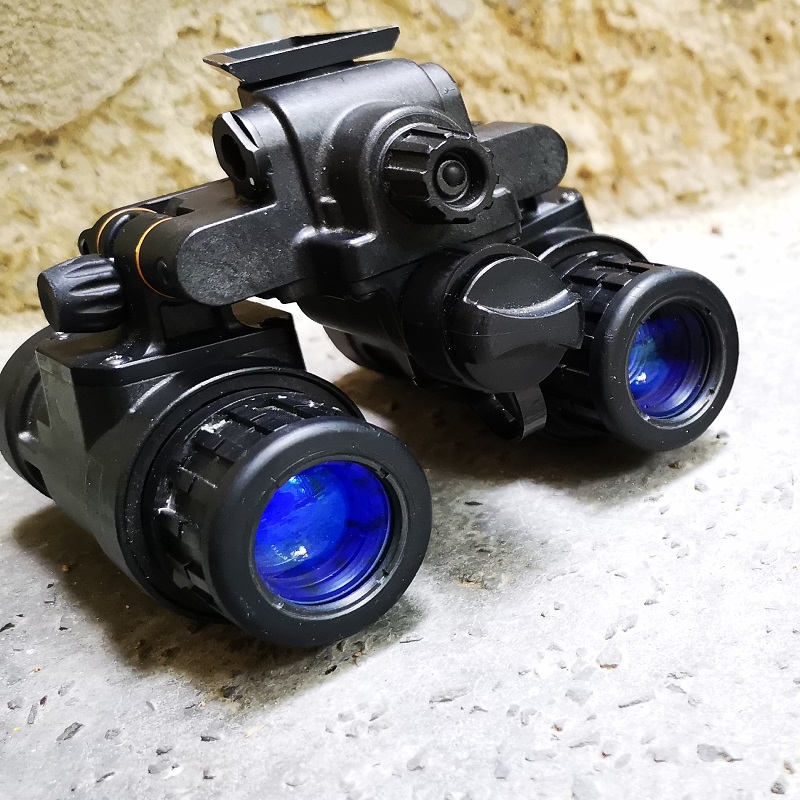 There it is in all its glory. Around 10.5 x 10.5 x 8.5 cm small and 490g light with AA batteries required for operation. A little powerhouse, if you will. Handling is similar to other devices. To activate, the rotary switch above the battery compartment must be pressed (not turned) and the device turns on.
There it is in all its glory. Around 10.5 x 10.5 x 8.5 cm small and 490g light with AA batteries required for operation. A little powerhouse, if you will. Handling is similar to other devices. To activate, the rotary switch above the battery compartment must be pressed (not turned) and the device turns on.
The designation AN/PVS-31 BNVD, as is typical for America, is a single abbreviation orgy. The "AN/PVS" part means according to the Army standard "Joint Electronics Type Designation System (JDETS)" Army Navy/Portable Visual Search. The BNVD stands for "Binocular Night Vision Device," approximately meaning "binocular night vision device."
The external values
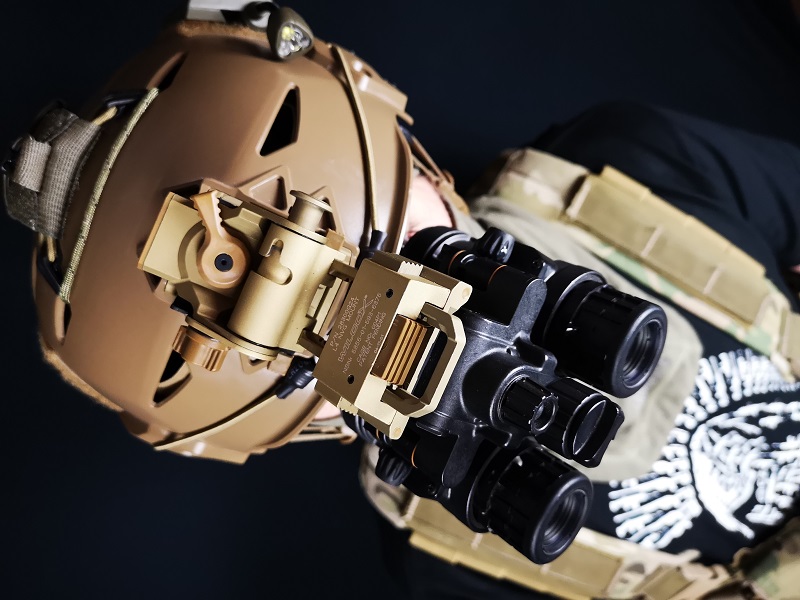 The AN/PVS-31 in its natural habitat, on the helmet. Repeat the same process to turn it on. The brightness ("Gain") can then be adjusted during operation using the rotary switch. Simple and practical.
The AN/PVS-31 in its natural habitat, on the helmet. Repeat the same process to turn it on. The brightness ("Gain") can then be adjusted during operation using the rotary switch. Simple and practical.
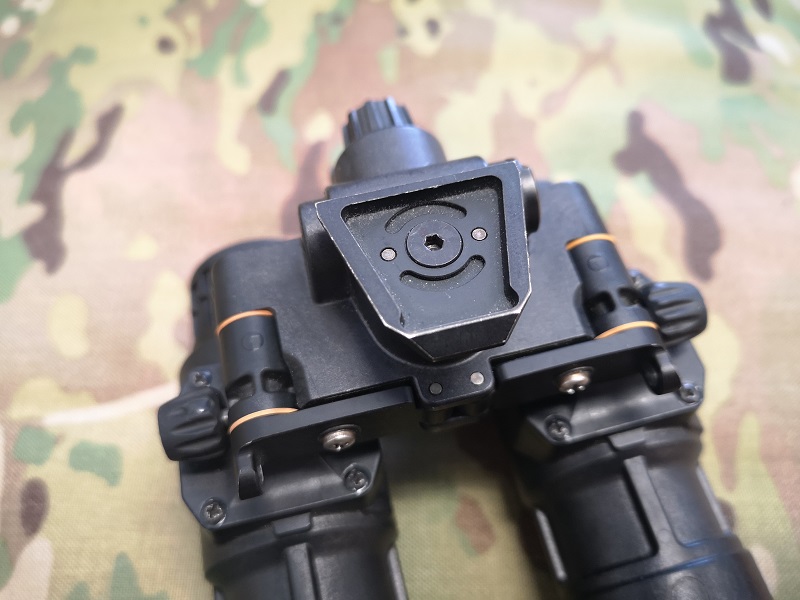 The AN/PVS-31 is attached via Dovetail to the Rhino, which is inserted in the shroud screwed to the helmet. We tested it with several NVG arms (including Wilcox and Nortons) and it held up perfectly with all of them. The device is also waterproof up to 20m for an hour. Probably longer, but it's not guaranteed.
The AN/PVS-31 is attached via Dovetail to the Rhino, which is inserted in the shroud screwed to the helmet. We tested it with several NVG arms (including Wilcox and Nortons) and it held up perfectly with all of them. The device is also waterproof up to 20m for an hour. Probably longer, but it's not guaranteed.
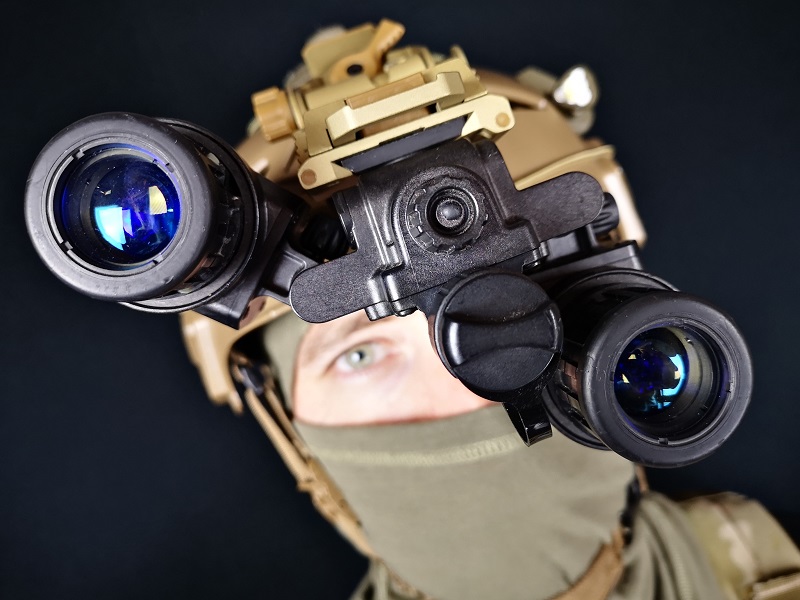 The two tubes on the AN/PVS-31 can be individually folded to the side. This adjusts the appropriate eye distance.
The two tubes on the AN/PVS-31 can be individually folded to the side. This adjusts the appropriate eye distance.
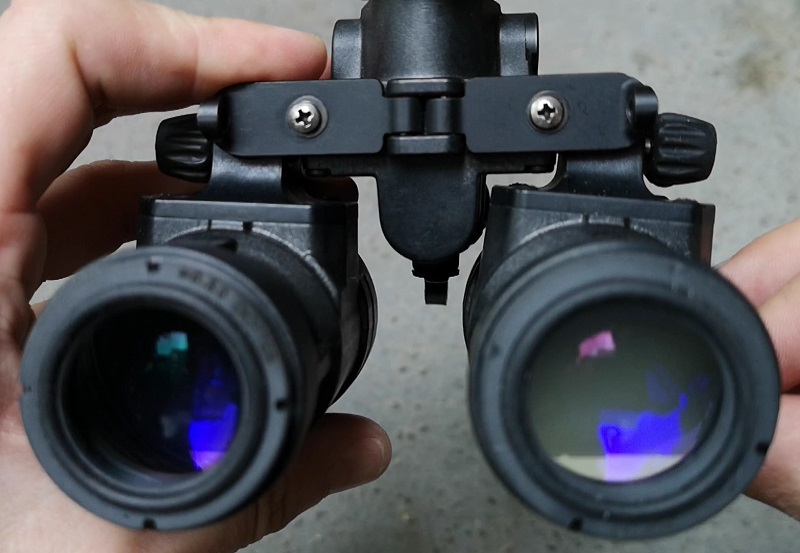 To avoid having to adjust this every time, there is a set screw on each side that limits the tilt of the tubes.
To avoid having to adjust this every time, there is a set screw on each side that limits the tilt of the tubes.
 What must not be missing are the loops to hang the helmet bungees. They serve as securing devices and also keep the entire mounting arm under tension, making it easier to adjust the night vision device.
What must not be missing are the loops to hang the helmet bungees. They serve as securing devices and also keep the entire mounting arm under tension, making it easier to adjust the night vision device.
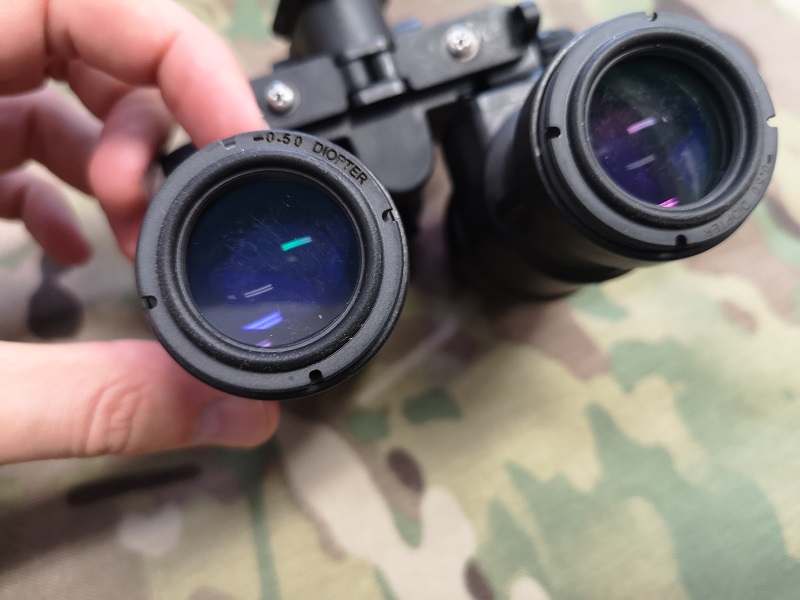 What stands out in comparison with night vision devices like the PVS-14 or Mini-14 is the absence of an adjustable diopter correction on the eyepiece. This is fixed on the AN/PVS-31. This has the great advantage of saving weight and length.
What stands out in comparison with night vision devices like the PVS-14 or Mini-14 is the absence of an adjustable diopter correction on the eyepiece. This is fixed on the AN/PVS-31. This has the great advantage of saving weight and length.
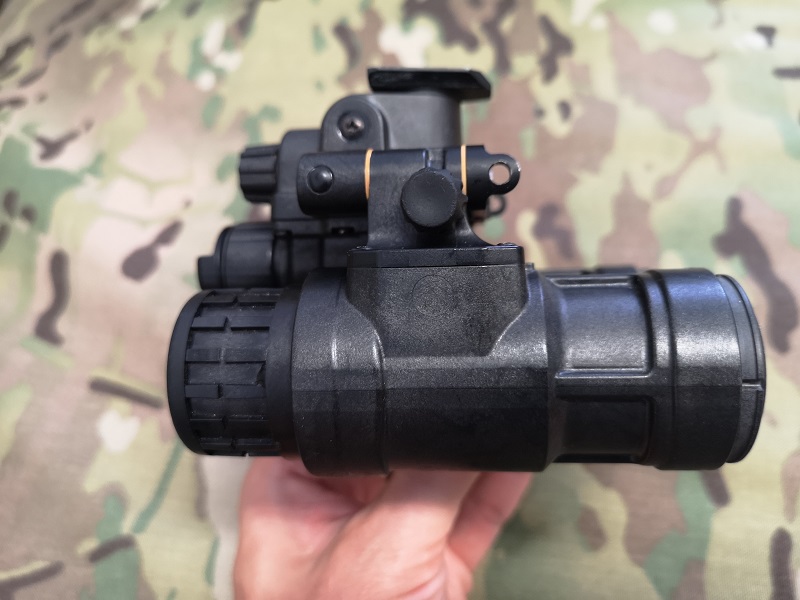 The AN/PVS-31 looks very compact. For comparison, a PVS-14 is about a centimeter longer.
The AN/PVS-31 looks very compact. For comparison, a PVS-14 is about a centimeter longer.
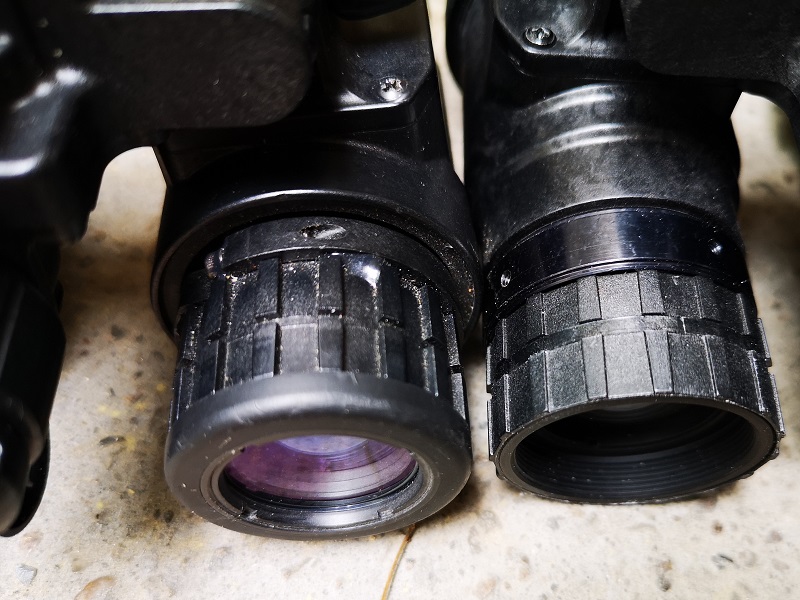 On the left in the picture is the objective of the AN/PVS-31, to the right of it is the PVS-14 design. Here, and also in the other photos, it is very noticeable that a lot has changed with the lens. The front focusing on the device is still done by manual rotation, but the edge sharpness in the AN/PVS-31 is unbeatable compared to the old 14, especially noticeable in motion. The view through the night vision device looks very natural, except for the lack of color, of course.
On the left in the picture is the objective of the AN/PVS-31, to the right of it is the PVS-14 design. Here, and also in the other photos, it is very noticeable that a lot has changed with the lens. The front focusing on the device is still done by manual rotation, but the edge sharpness in the AN/PVS-31 is unbeatable compared to the old 14, especially noticeable in motion. The view through the night vision device looks very natural, except for the lack of color, of course.
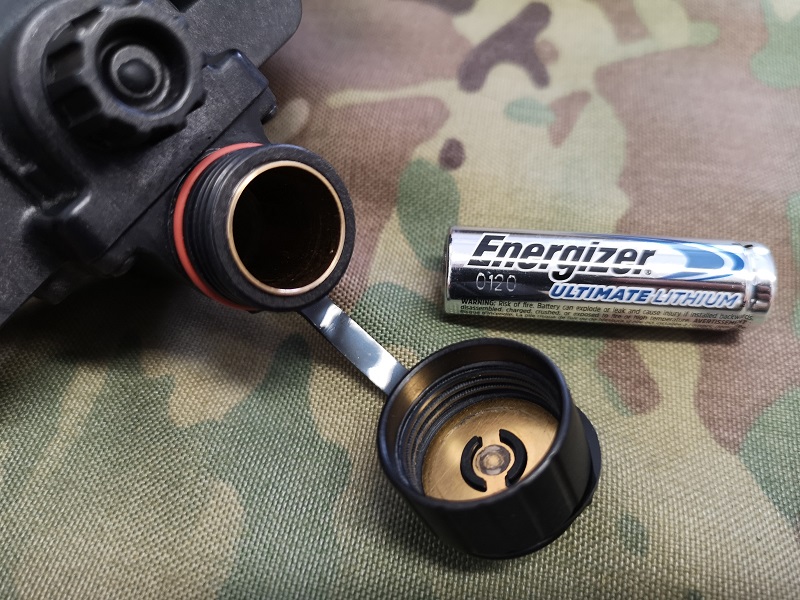 The battery compartment is screwed and equipped with an O-ring seal. The lithium AA battery goes in with the positive pole forward and provides 15 hours of operation. That's quite impressive. With a regular alkaline battery, you get around 10 hours of operation. This is influenced by the outside temperature.
The battery compartment is screwed and equipped with an O-ring seal. The lithium AA battery goes in with the positive pole forward and provides 15 hours of operation. That's quite impressive. With a regular alkaline battery, you get around 10 hours of operation. This is influenced by the outside temperature.
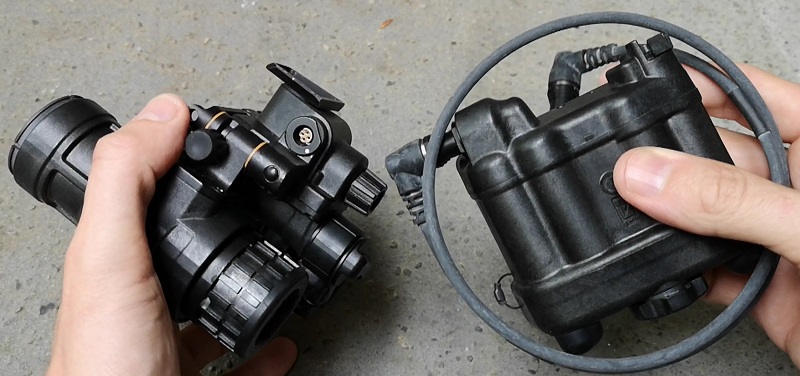 For those who need more power, there is the PVS-31 Battery Pack - HERE in our SPARTANAT Review. With that, you'll have juice for up to 50 hours. But who needs that? During arctic winter nights, the Battery Pack guarantees energy supply when batteries are under extreme demands.
For those who need more power, there is the PVS-31 Battery Pack - HERE in our SPARTANAT Review. With that, you'll have juice for up to 50 hours. But who needs that? During arctic winter nights, the Battery Pack guarantees energy supply when batteries are under extreme demands.
The internal values
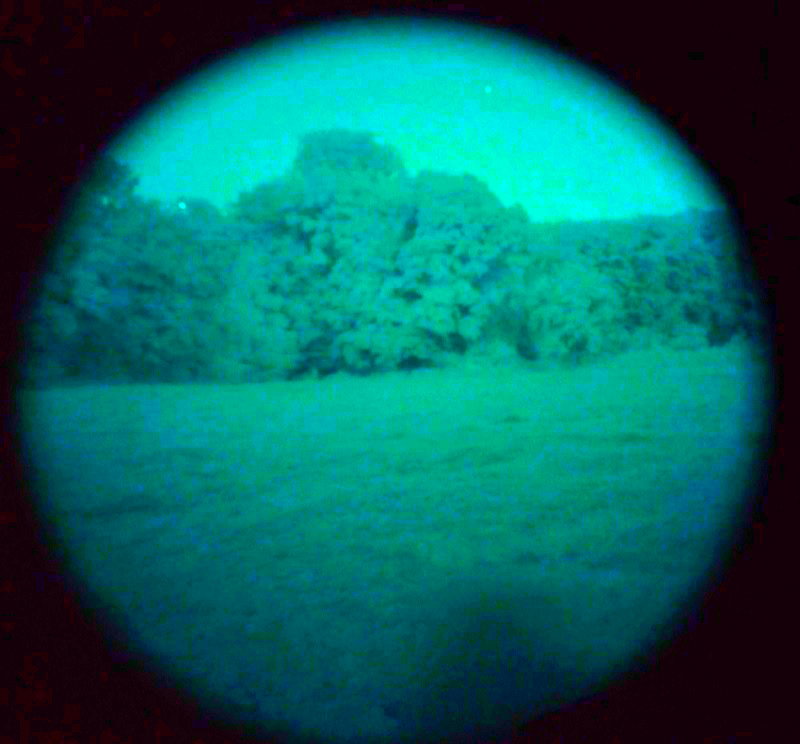 So much about the external values of the AN/PVS-31. However, the truly fascinating part of any night vision device is the image intensifier tube inside. This largely determines the cost of a night vision device. Those who skimp here should not later be upset about poor image quality. In our AN/PVS-31, there is an L3 Gen3 unfilmed tube with white phosphorus installed, with over 2000 FOM. In short, one of the most advanced image intensifier tubes for special forces.
So much about the external values of the AN/PVS-31. However, the truly fascinating part of any night vision device is the image intensifier tube inside. This largely determines the cost of a night vision device. Those who skimp here should not later be upset about poor image quality. In our AN/PVS-31, there is an L3 Gen3 unfilmed tube with white phosphorus installed, with over 2000 FOM. In short, one of the most advanced image intensifier tubes for special forces.
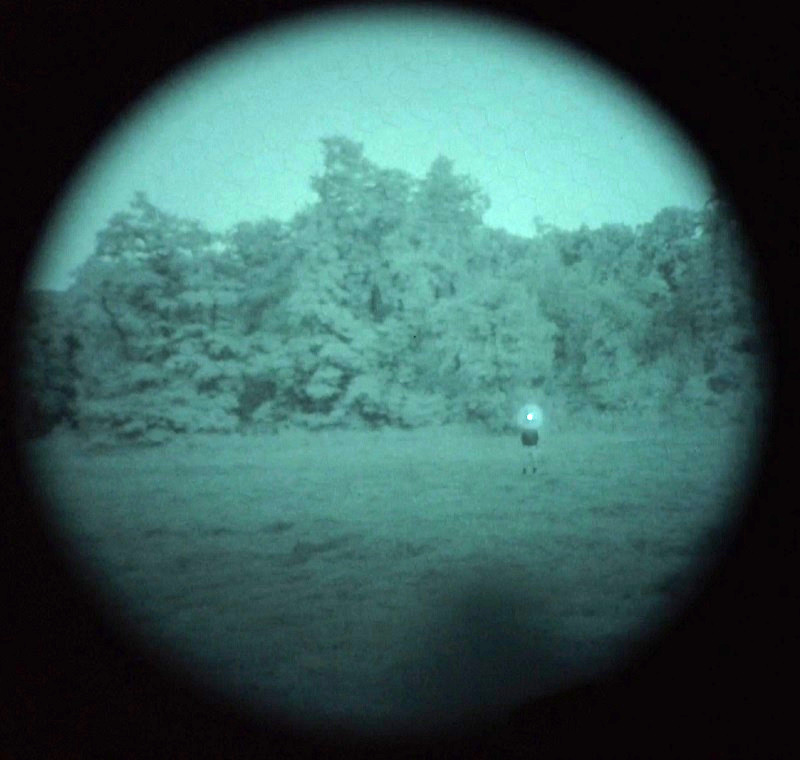 A person can easily be identified on this starry new moon night at 60m. Even better if they activate their IR beacon. The image was even sharper in reality than shown in the photo. Also recognizable is the slight honeycomb pattern at the edges, caused by the microchannel plate that multiplies the electrons in the device.
A person can easily be identified on this starry new moon night at 60m. Even better if they activate their IR beacon. The image was even sharper in reality than shown in the photo. Also recognizable is the slight honeycomb pattern at the edges, caused by the microchannel plate that multiplies the electrons in the device.
SPARTANAT is the online magazine for Military News, Tactical Life, Gear & Reviews. 
Send us your news: [email protected]
Ad
similar
Get the weekly SPARTANAT newsletter.
Your bonus: the free E-Book from SPARTANAT.


